
Electrifying photos Diana told me would ‘disarm her enemies’ in Royal Family
Richard Kay – The Daily Mail
London: For the most photographed woman on the planet, it was just another routine assignment in front of the camera.
But by the time Diana left the anonymous East End studio on that summer’s day in 1990, the way the world saw the Princess was set to change — and change utterly.
The frozen formality and aloofness of royal portraiture had been ripped up, replaced by a glamour and sensuality that oozed sex appeal.
And if the black and white pictures that were shot that day of a laughing Diana in a tiara with her bare arms wrapped around her knees were electrifying for the Princess, they were transformative for the man behind the lens.
Patrick Demarchelier, who has died aged 78, was already a leading fashion photographer but the turbo-effect of his collaboration with Diana turned him into the most sought-after in the world.

Hollywood divas, leading men and rock’n’roll stars competed to be snapped by the craggy Frenchman who had given Diana the allure and sheen of a supermodel.
He was in demand from a multitude of top magazines including Vogue, Harper’s Bazaar, Elle and Rolling Stone, as well as from many high-end fashion brands. He helped shoot advertisement campaigns for Dior, Chanel, Yves Saint Laurent, Tommy Hilfiger and Carolina Herrera.
Beyonce, Jennifer Lopez and Madonna all modelled for him and he was name-checked in the film The Devil Wears Prada, the biting satire on the fashion industry starring Meryl Streep.
But four years ago the dark side of his fame threatened to destroy this glittering, hard-won reputation. Demarchelier was among 25 photographers, agents, stylists, casting directors and other industry professionals accused in the wake of the #MeToo movement of sexual misconduct.
The charge sheet against him was particularly explicit, including from his former assistant who said she had been the subject of ‘relentless’ advances from when she was a 19-year old intern. In the end she claimed she had given in to his sexual demands fearing she could lose her job if she turned him down.
Six other women complained of unwanted sexual exploitation including him ‘thrusting a model’s hands on to her genitals and grabbing another model’s breasts, as well as making vulgar propositions’.
On an earlier occasion a teenage model claimed he had asked her if he could perform a sex act on her and indicated that if she agreed he could make her famous.
Patrick Demarchelier angrily refuted all the allegations insisting the claims were ‘ridiculous’ and ‘pure lying’. As a happily married father of three sons, he said he had ‘never, never, never’ touched a model inappropriately.
But for all his denials the magazine publisher Conde Nast, owners of Vogue, Glamour and GQ, suspended its work with him.
This must have been the cruellest repudiation of all. For it was with Vogue that Demarchelier’s formidable relationship with Diana began.
No foreign photographer had ever been invited to take an official portrait of a British royal before. And none would have presumed to photograph the Princess of Wales smirking, chin on hands in a black roll-neck sweater or coyly seductive with damp, swept-back hair in a daringly revealing crossover halter-neck dress.
The pictures were not just iconic images, of course, but also a vital element of Diana’s effort to fight back as her marriage to Prince Charles unravelled. From her gaze to her expression of resolute confidence, they were, as she told me, designed to ‘disarm my enemies’.
Who were they, I asked. Diana rolled her eyes: ‘Those in my husband’s family who want me to simply disappear.’

Never had she used the power of the camera as she did through her partnership with Patrick Demarchelier.
Only very rarely does a photograph capture something far greater than simply the subject in front of the camera.
He and she both instinctively knew that the story their shots encapsulated were, on almost every occasion, far bigger than what we could immediately see.
This was the image Diana wanted to project in the five years of their working relationship to show that she was dealing with the crises that might have overwhelmed her.
They were not just challengingly defiant with no sign of self-pity, they also possessed a radiance that said ‘Here I am’.
Over the years, Demarchelier shot a whole raft of Hollywood A-listers and nearly every top model, sports personality, rock god and celebrity.
A book of his portraits taken from the mid-1980s to the late-1990s include a reflective Gianni Versace, Cameron Diaz kissing actor Matt Dillon, a bikini shot of Kate Moss and a close-up of the sculpted body of the boxer Evander Holyfield.
Other commissions included actors Robert De Niro and Warren Beatty — both close friends — Meg Ryan, and Sting and his wife Trudie Styler. But the ones that we remember, the ones that really stood out, were of Diana.
The Princess had asked to meet Patrick Demarchelier after admiring his portfolio of a windswept laughing model cuddling a child in Vogue, whose then deputy editor Anna Harvey, was a close friend.
One day in the summer of 1990, Harvey arranged for Diana to join a shoot at a studio in Hackney, East London. The timing was intriguing.
It was around the time that Prince Charles had broken his arm playing polo and when Diana felt she was being discarded by her husband.
As he recovered in hospital from the complicated fractures, it was the company of Mrs Camilla Parker Bowles, rather than his wife, that the prince preferred.
Even so, it was two years before the couple were to separate formally and to the outside world, at least, they remained apparently happily married. But Diana was already embarking on a new, independent phase to her life.
What better, she thought, than a set of photographs that would illustrate this and set her apart from the rest of the Royal Family.
In a way Demarchelier was just the man to show this new liberation. Brought up ‘poor’ in the port city of Le Havre, northern France, he was one of five boys of divorced parents.
At 18 his stepfather gave him a Kodak camera and he was hooked. His first job was at a small lab in the area printing passport pictures.
Eventually, after moving to Paris, he began photographing budding models for their ‘look books’ to show agents.
Soon, he was working for French Elle and Marie Claire and was quickly part of what was known as ‘the French mob’, a group of young fashion photographers known for their ‘heterosexuality’ and their ‘happy snaps’.
When he was in his 20s he moved to New York. With only a few words of English but a stunning portfolio, he arrived in 1975 to a disappointing reception.
American fashion editors found his work ‘too European’. With little or no work, he spent his nights learning English at evening classes.
Slowly, the commissions did start to trickle in but it wasn’t until 1979, when the legendary editorial director of Conde Nast in New York, Alexander Liberman, spotted his potential, that Demarchelier finally got his big break and he was on his way to joining fashion royalty.
When the request for a meeting came from Diana, however, he was flattered. ‘I didn’t look on it as a job,’ he later recalled. ‘It was a pleasure, an honour.’
Much of the shoot involving other models had already been completed when Diana, dressed in a business suit and polka-dot blouse walked in. As well as the photographer and his subject, there was one other key figure, a young Scottish hairdresser called Sam McKnight.
It was the first time he had ever had to put a tiara on a ‘model’, but before doing so he made a suggestion that was to kickstart Diana’s metamorphosis. He cut her hair short, shorter, in fact, than it had ever been before.
The resulting picture first appeared in the December 1990 issue of Vogue — and it caused a sensation. It remained one of Diana’s all-time favourites. Close friends would receive signed copies, and a framed version occupied pride of place in her Kensington Palace sitting room.
Years later it was still turning heads when it went on show at the National Portrait Gallery in 2016.
From then, not only did Demarchelier become the Princess’s personal photographer, the softly-spoken McKnight was entrusted with looking after her hair.
It was his idea that Demarchelier should later picture her, in bejewelled Versace, with slick-backed hair modelled on a style he had developed for a shoot with the American supermodel Christy Turlington. Diana loved it.
Indeed, Diana loved all the pictures Demarchelier took of her.As for the photographer, he was rhapsodic.
‘The Princess is like the sun, she shines from the inside,’ he said. ‘She’s a classic beauty, tall and skinny, and it isn’t difficult to photograph her. She is pretty inside and she is pretty outside.’
Soon, he was being invited to Highgrove to take private pictures of William and Harry for Diana’s personal collection.
And he was suddenly in demand from other royals; Queen Sofia of Spain asked him to picture her in Madrid and he captured a relaxed Duchess of Kent, then 58, for Tatler which made her look both sexy and 20 years younger.
With Demarchelier’s success came riches. A Manhattan apartment which he shared with his Swedish ex-model wife Mia and their sons, a summer house on Long Island and a villa on the Caribbean island of St Barts.
In 1995 he lent the villa to Diana for a week-long holiday. It was an idyllic break for the Princess, then in the midst of brutal negotiations over her marriage and separation.
Demarchelier shot some of his most famous pictures in the Caribbean, including Kate Moss and Claudia Schiffer, but none of Diana.
Thanks to his worldwide fame, the photographer found himself at the centre of a bidding war between rival magazines Vogue and Harper’s Bazaar. He chose Harper’s and Diana came too.
But by the end of 1995, the relationship had changed. Diana, in the aftermath of her Panorama interview, was seeking a new look — and someone else to capture it. She turned to Mario Testino.
Rumours abounded that Demarchelier had made a pass at her. If so, it was hardly unusual. Diana was constantly the target of male attention and she always deftly handled it. More importantly, she once described him as a ‘dream’ and adored his heavily accented English.
It is more likely she simply wanted a younger, more modern photographer to picture her.
His career, however, continued. He was among an elite group of photographers to shoot the prestigious Pirelli calendar on more than one occasion, but his work transcended royalty, fashion and glamour and he photographed Hillary Clinton for the cover of Time magazine, and Madonna for her album Bedtime Stories.
Among his more unusual assignments was a commission to photograph Cherie Blair, wife of then Labour PM Tony Blair, in 2004 for a shoot in the U.S. glossy Harper’s Bazaar.
With its striking black and white imagery and minimal make-up, the pictures channelled his Diana portraits. As model Naomi Campbell noted of the Frenchman, he has ‘the ability to make every woman he photographs look incredibly beautiful’.
Despite the tarnishing of his reputation by the allegations made against him in 2018, his death was mourned yesterday by some of the most glamorous figures he had photographed.
Many queued up to pay tribute to him, including Cindy Crawford, Bella Hadid, Christie Brinkley, actress Kate Hudson and designer Vera Wang, who said she was ‘saddened to the core’ by his passing.
While it was Demarchelier’s skill as a fashion photographer that had entranced Diana, it was the natural beauty that he drew from her which makes his pictures of her so timeless.
